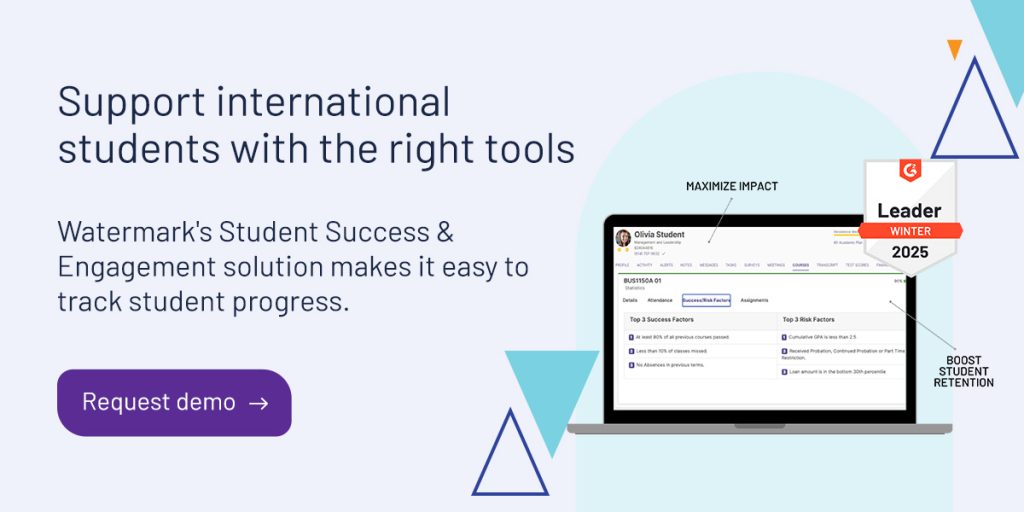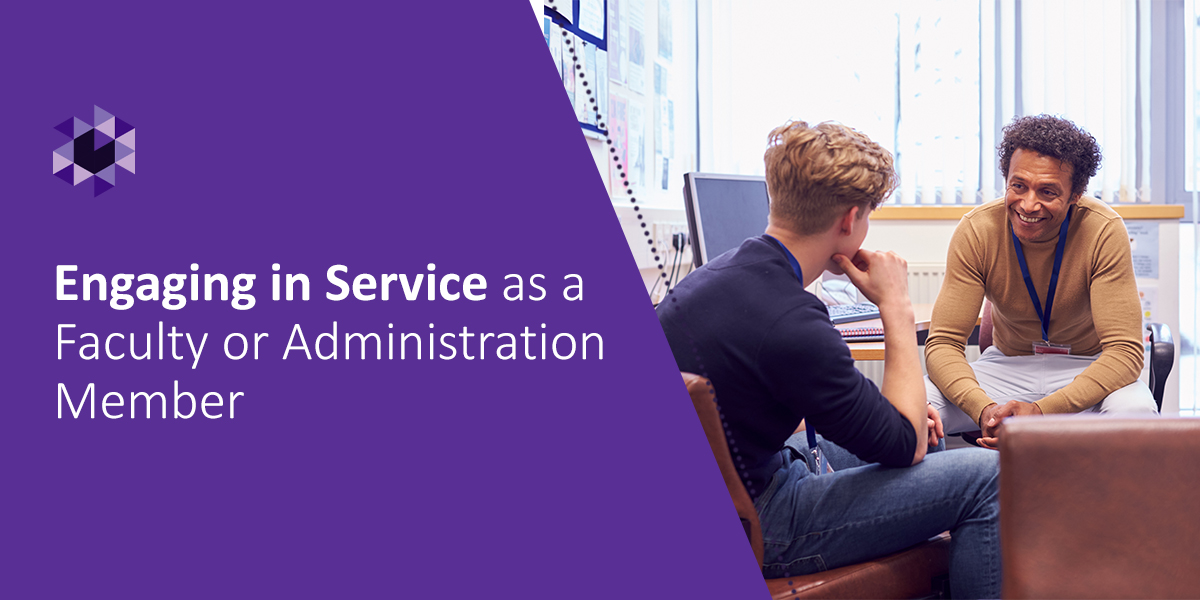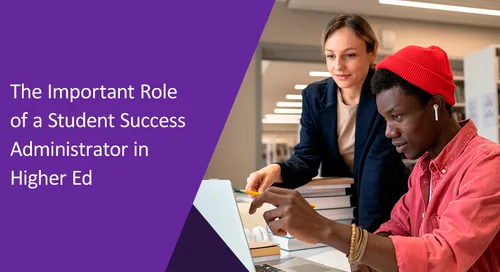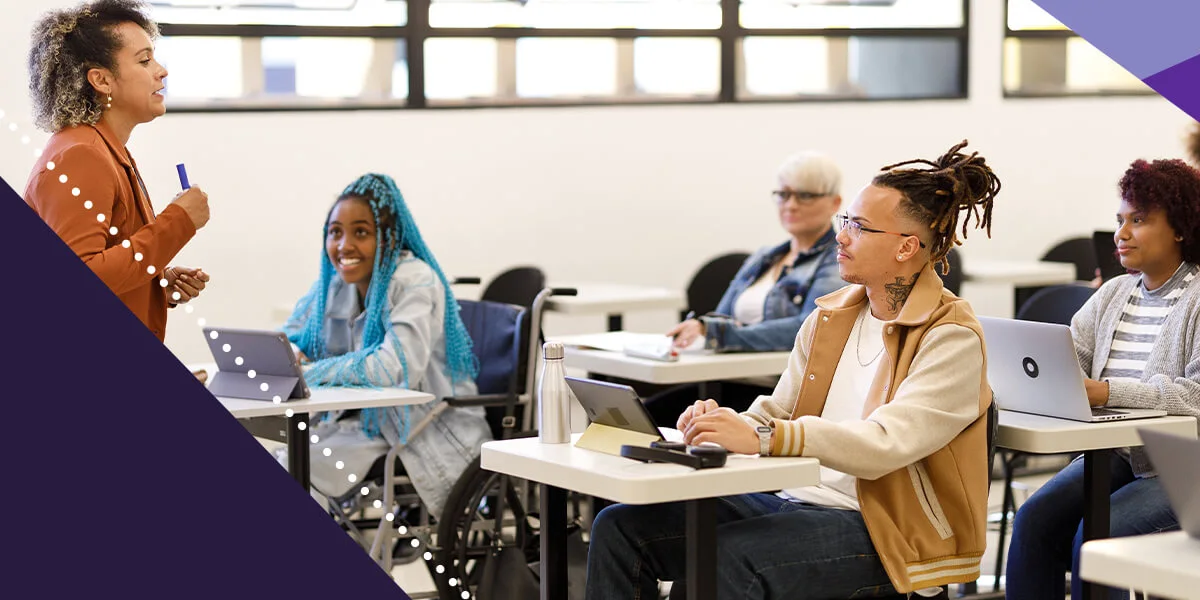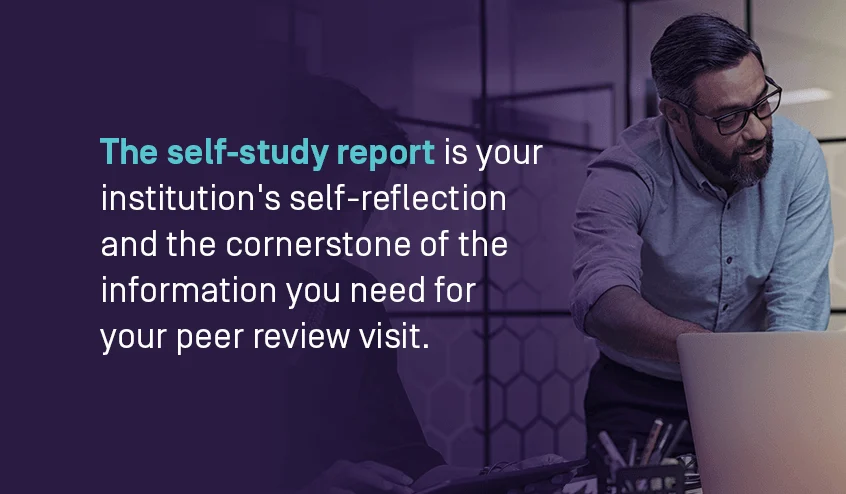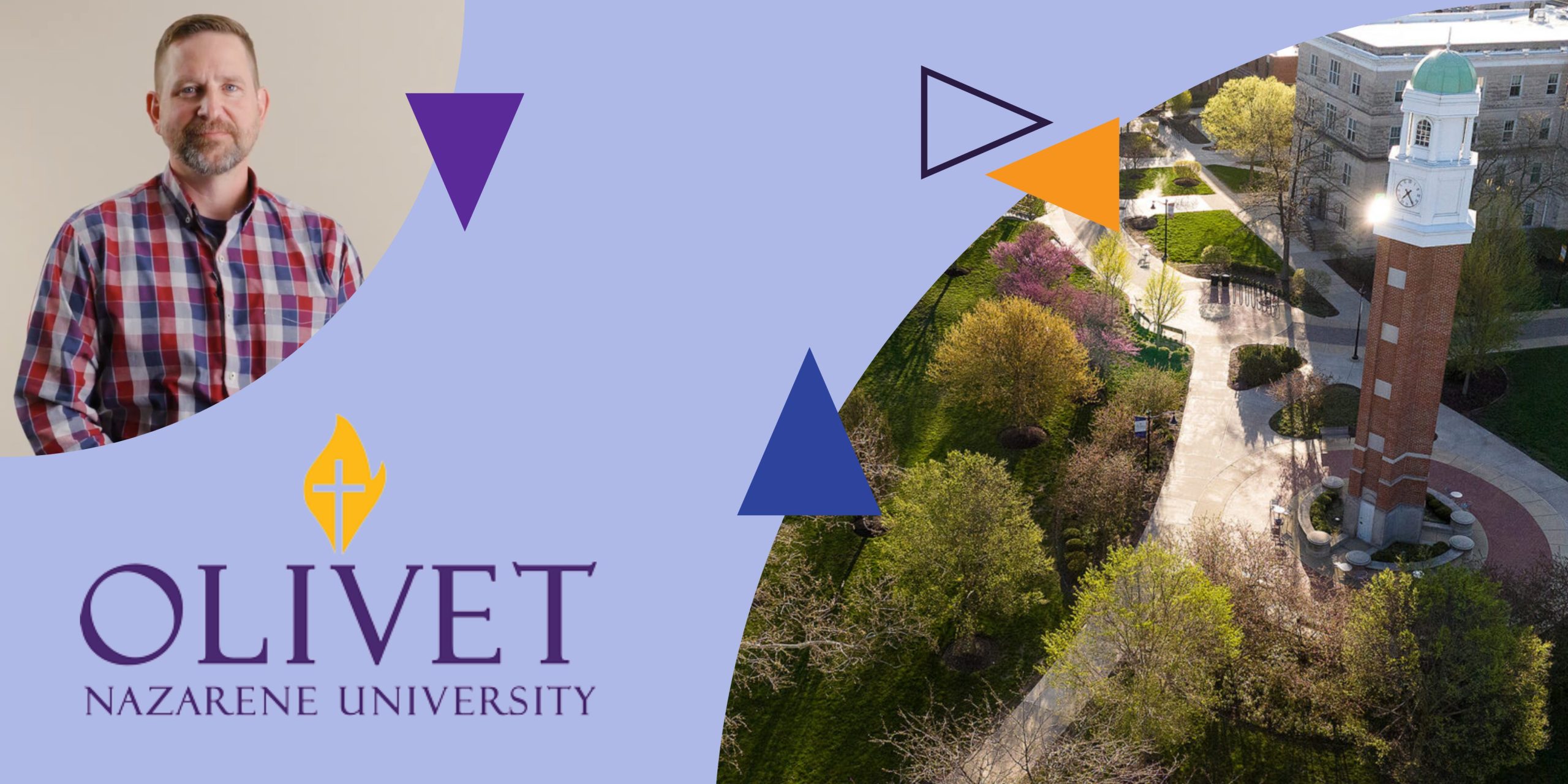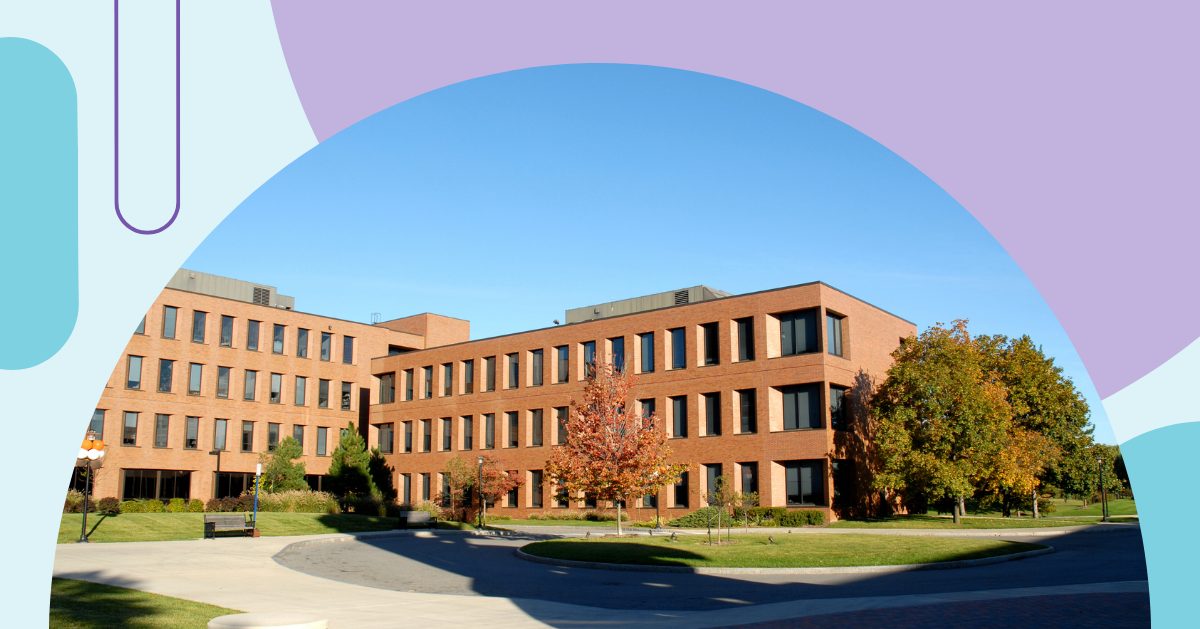
The United States is one of the top destinations for international students seeking higher education. During the 2022-2023 academic year, the U.S. hosted over 1 million international students, the fastest enrollment growth rate it’s seen in 40 years. However, changing geopolitical dynamics have an impact on enrollment rates and international student success. Language barriers, accommodation, culture shock, and homesickness are just a few other challenges international students may face.
Therefore, it’s crucial for higher education institutions to focus on how they can best offer their support. Why? Because diversity enriches your institution in more ways than one. Their unique perspectives, traditions, and experiences enrich your campus and community. And an inclusive environment that values diversity opens doors to connections, collaboration, and cross-cultural understanding.
Learn more about how higher education institutions can support international student success.
Understanding the importance of supporting international students
International students play an important role in many higher education institutions, through:
- Culture diversity
- Global networking
- Economic contributions
- Community engagement
- Enriching the learning environment
Their culture and diversity provide new perspectives and ideas that U.S. institutions can use to foster a globally inclusive academic environment. Their presence itself helps prepare domestic and international students for an increasingly interconnected world. Having a culturally rich campus even develops key workforce attributes. For instance, engaging with peers from different backgrounds broadens worldviews and builds cross-cultural communication skills — opening global networking opportunities.
Beyond academics, international students also make economic contributions. Many higher education institutions rely on tuition from international students as they often pay higher out-of-state or international fees. Some international students may pay more than two or three times the amount, depending on where and what they study. Their cost of living in the U.S. also fuels local economies through housing, internet, transport, dining, and retail.
Despite their many contributions, international students face unique challenges that require institutional support. These challenges can include:
- Cultural adjustment: Social norms and value differences students may experience can range from communication styles and social interactions to gender roles and holidays. In addition to familiarizing themselves with a new country, they must also navigate unfamiliar social norms and academic expectations.
- Language barriers: Many institutions require international students to pass a language test before enrollment, but challenges in comprehension can still hinder their ability to fully engage in classroom discussions. As a result, it can impact their academic success and confidence. The language barrier may also affect their social life and ability to adjust to the new environment.
- Immigration issues: Furthermore, immigration policies and visa regulations can be daunting for some, which adds stress to an already complex transition. International students will have to navigate immigration laws and regulations while balancing their academic careers. Without proper guidance or support, it may hinder student retention rates for institutions.
Key challenges faced by international students
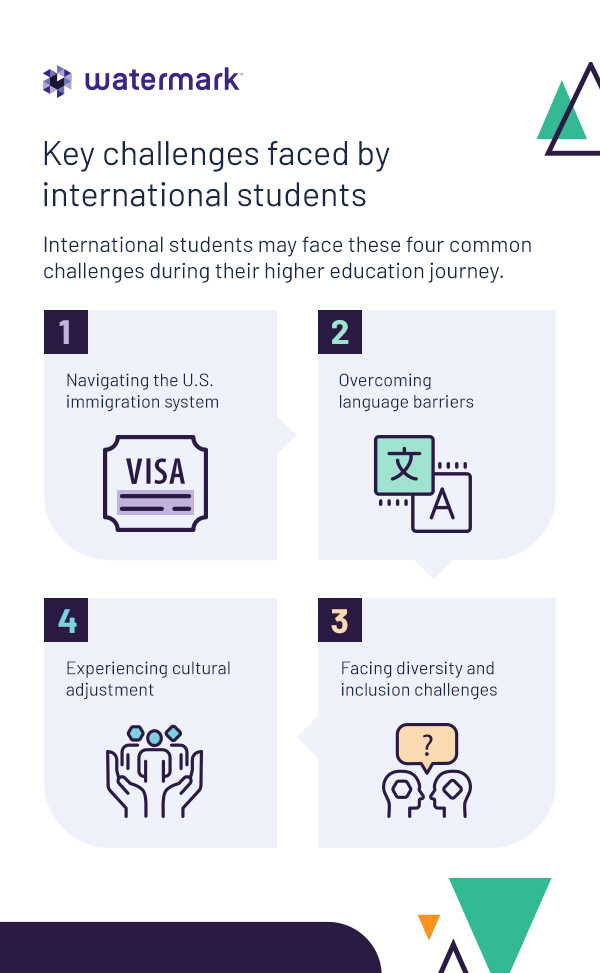
International students bring invaluable diversity and fresh perspectives to higher education institutions. That said, they often encounter unique challenges that can impact their success and, potentially, their well-being. However, understanding these obstacles allows institution administrators and decision-makers to better develop support strategies.
International students may face these four common challenges during their higher education journey.
1. Navigating the U.S. immigration system
The U.S. immigration system can be complex. It requires international students to diligently adhere to student visa regulations to maintain their legal status. In the U.S., the F-1 or M-1 visas are the two main student visas. The J-1 visa classification is another option. International learners must understand them to comply with their institution’s enrollment requirements.
Additionally, they must stay informed of any visa policy changes that may affect their stay. While some higher education institutions may inform their foreign learners of such changes, not all do.
The uncertainty surrounding immigration policies can add significant stress, as even minor infractions may jeopardize their ability to continue their education. For instance, recent political shifts have led to heightened concerns about potential changes in visa policies, causing anxiety among the international student community.
2. Overcoming language barriers
Language proficiency is a common hurdle for many international students, particularly those for whom English is not a first language. Even with fair English language skills, understanding academic jargon and participating in conversations in a different language can be intimidating.
Additionally, educational systems vary globally. As such, international students may have to face unforeseen challenges, like adjusting to different:
- Teaching styles
- Assessment methods
- Classroom dynamics
While many will become accustomed, the adjustment period does differ per student, which can affect their academic performance and confidence.
3. Experiencing cultural adjustment
Acclimating to a new language isn’t the only adjustment — international students must also adapt to a new cultural environment. They may experience new:
- Traditions
- Behaviors
- Social norms
The culture shock might leave some learners feeling homesick or even isolated — and the absence of familiar support systems can exacerbate these emotions. It’s thus essential for institutions to offer student resources that foster cultural integration and community building. These resources and programs can bridge cultural gaps and provide a sense of belonging.
4. Facing diversity and inclusion challenges
Although international students can contribute to the institution’s diversity, it comes with a cost. As minorities within the student body, they might face microaggressions or discrimination, which, in the end, can affect their mental health and academic success.
That’s why institution decision-makers must create an inclusive campus climate. Students, faculty, and staff must be culturally competent or receive appropriate training.
Strategies for supporting international student success
Higher educational institutions need to take a proactive approach to address these challenges. Implementing support strategies for international students ensures their academic success — as well as an inclusive social environment and culturally rich and welcoming campus.
Consider implementing these five strategies to help international students, their academics, and retention rates.
1. Orientation programs
Implementing an international student program is a great place to start. The main goal of an international student orientation (ISO) program is to help ease the transitioning phase into higher education life in a different country.
Traditional orientation programs, also known as orientation week, create familiarity with the institution’s regulations and academic standards — and introduce new students to each other. There are various events held during this orientation period, each providing students with the necessary tools and knowledge to enhance their academic journey.
However, unlike standard orientations, these ISO programs can go beyond general campus introductions. The focus is solely on the specific needs of international students. Institution decision-makers can customize this concept to include topics such as:
- Cultural adjustment: This topic should aim to help international students understand local customs and social norms to reduce culture shock.
- Academic expectations: Explain the academic differences like grading systems, instruction methods, classroom etiquette, and professor-student interactions.
- Immigration guidance: Give international students clear, simplified information on maintaining their visa status and even their legal rights.
- Campus and community resources: Provide foreign learners with information and resources on all the available support services your campus offers. These supportive resources could include international student offices, counseling services, and tutoring centers.
In conjunction with the above, there are various other orientation tactics — online and in-person — to consider. You can implement these ideas pre- or post-student arrival:
- Questions and answer sessions with current students
- Asynchronous campus and general information videos
- Video testimonials from current international students
- Welcome kits filled with swag and guidance documents
- Social mixers with international student support staff
- Group excursions to off-campus locations
2. Mentoring and peer support
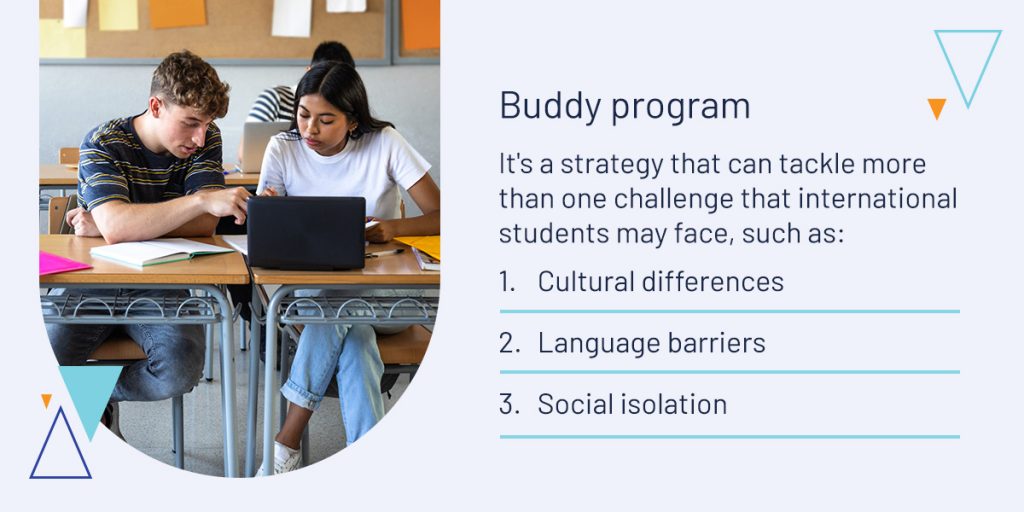
Many international students may struggle with adapting to both new academic and cultural settings. But pairing them with local students or experienced international students through a structured mentoring program can make all the difference while adding a personal touch.
You may also know this strategy as a “buddy program.” It’s a strategy that can tackle more than one challenge that international students may face, such as cultural differences, language barriers, or social isolation. Peer-to-peer mentoring aims to:
- Provide academic and social guidance: Mentors are the first line of guidance. They’re there to help new international students with anything from understanding academic expectations to engaging in campus life.
- Offer emotional support: Having a trusted mentor can reduce potential feelings of social isolation through emotional support. They can also help international students navigate social and cultural differences.
- Encourage cross-cultural exchange: This program benefits mentors just as much as it benefits mentees. Both have the opportunity to learn more about each other’s perspectives, traditions, cultures, and even global issues.
Mentoring international students can be simple. Here are three simple steps institutions can follow to implement a mentoring program:
- Establish a formal application and matching process.
- Provide training for mentors to equip them with the necessary skills and knowledge.
- Organize regular check-ins or meetings to keep students engaged and supported.
3. Language support services
A language barrier between international students and their peers, lecturers, and staff may result in a few disadvantages ranging from academic to social or cultural challenges. However, institutions can help by offering language support services, such as:
- English language workshops: Schedule regular workshops for international students. Each English workshop can focus on a different element that can help with their academic success, like academic writing or presentation.
- Tutoring centers: While some flourish in group learning, others flourish in one-on-one support. Offer tutoring to help international students improve various elements of English, from comprehension to writing.
- Language buddy programs: Using the “buddy system,” institutions can also use this concept to break down language barriers. Pair international students with native English-speaking students to help them practice their language skills in an informal setting.
- Integrated language support: Institutions can also embed language assistance within courses. Offering such integrated language support provides international students with context-specific learning.
Additionally, there may be a disconnect between what international students and teachers are thinking. As such, here are a few communication tips lecturers must remember:
- Don’t make assumptions about a student’s English language proficiency.
- Learning English takes time, consistency, practice, and patience.
- Silence does not correlate with a lack of ability or interest.
- Allow time for pauses or silence during discussions.
- Encourage peer-to-peer discussions or projects.
- Provide lecture subtitles or transcripts.
4. Cultural integration initiatives
Create various opportunities on your campus for cultural exchanges. Cultural integration initiatives allow students from different cultural backgrounds to come together.
Providing such opportunities can help international students feel more connected to their new environment while promoting global awareness among domestic students. There are various types of initiatives to consider, such as:
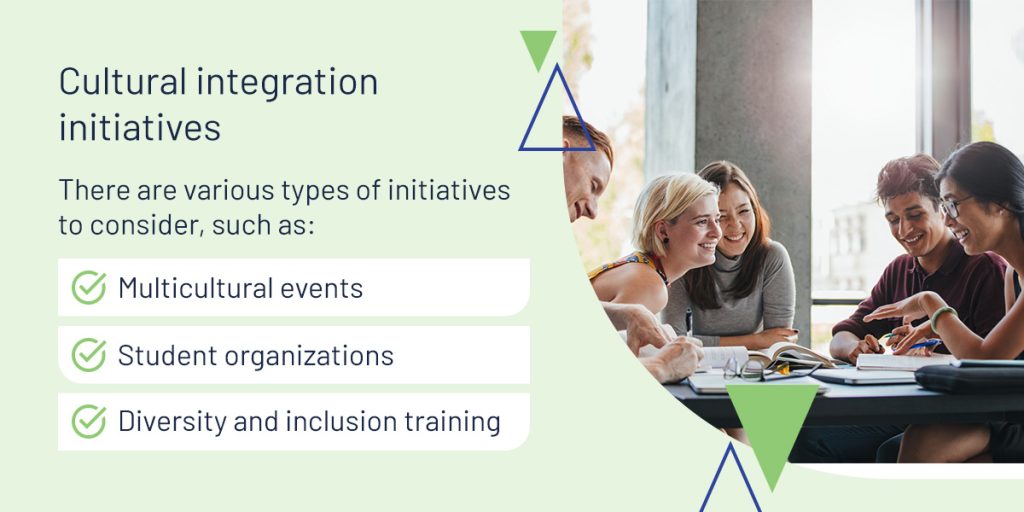
- Multicultural events: Celebrate different cultures and their traditions, food, and music. These festivals or events can help international students feel seen and help domestic students appreciate diversity in a fun way.
- Student organizations: Allow students to establish cultural clubs or organizations to promote and advocate for diversity on campus.
- Diversity and inclusion training: Whether it’s a workshop for students or a seminar for faculty, training can help with cultural education and appreciation.
5. Academic advising and counseling
International students face numerous unique academic and personal challenges at higher education institutions. However, institutional decision-makers can provide them with specialized advising and counseling services from day one and offer them as frequently as possible. This way, international students are aware of where and how to seek support if needed. The key components of a strong support system include:
- A dedicated team of international student advisors
- Comprehensive orientation programs
- Personalized academic planning
- Mental health and awareness support
- Career development guidance
- Language and communication support
- Peer mentorship programs
- Cultural integration initiatives
- 24/7 online advising and support platforms
The role of technology in supporting international students
Technology can be highly resourceful in helping international students succeed at your institution — and there are various tech solutions that may help address their unique challenges. Some solutions may offer features that allow:
- Spotting struggling students early: Smart systems can keep an eye on grades and participation to catch any early signs that students might be struggling. If something seems off, advisors get a heads-up so they can step in.
- Keeping track of student involvement: Some tools can help institutions see how engaged international students are. If they’re not as involved, institutions can reach out and offer ways of support.
- Gathering honest student feedback: Simple surveys make it easy for international students to share what’s working and what’s not. Institutions can use this feedback to make real improvements.
- Helping faculty support international students: A system that can track faculty development can encourage them to use more inclusive teaching methods. By understanding international student challenges, lecturers can adjust their approach.
- Improving support services over time: Institutions can use data to regularly check how well their international student programs are working. They can make the necessary improvements to offer the best academic experience possible.
Support international students with the right tools
By adopting technology-driven strategies, higher education institutions can create a responsive, data-informed support system that empowers their international students to succeed academically and personally. With the right tools in place, institutions can ensure their international students feel supported, which may help with retention and success rates.
Watermark’s Student Success & Engagement solution makes it easy to track student progress, provide timely interventions, and promote a sense of belonging. Request a demo today to learn how Watermark can help with smarter, data-driven solutions.
